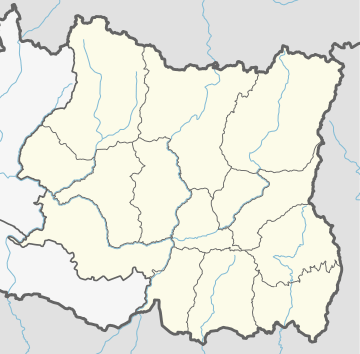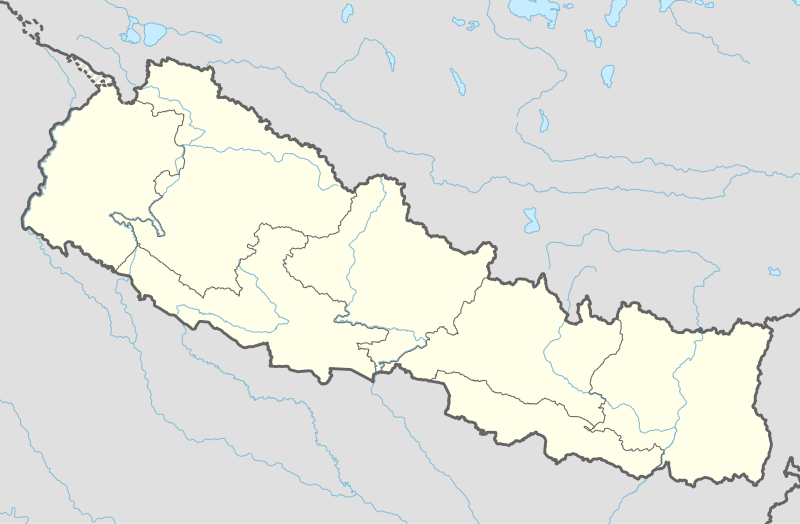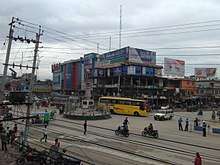Birtamod
Birtamode (Nepali: बिर्तामोड नगरपालिका) is a municipality in Jhapa District of Nepal. It is the commercial, educational and transport hub of Jhapa District. Sarnamati Bazar, Shivasatakshi Bazar, Kamatoli Bazar, Chakchaki Bazar and Surunga Bazar are some of the nearest local towns/settlements connected to Birtamod. Birtamod is the second largest city of Jhapaas well as in mechi zone.
Birtamode Municipality बिर्तामोड | |
|---|---|
 Birtamode Municipality Location of Birtamod in Province No. 1  Birtamode Municipality Birtamode Municipality (Nepal) | |
| Coordinates: 26°38′N 87°59′E | |
| Country | |
| Province | Province No. 1 |
| District | Jhapa |
| Government | |
| • Mayor | Mr Dhurva kumar siwakoti (NCP) |
| • Deputy Mayor | Pawitra Mahatara Parsai (NCP) |
| Area | |
| • Total | 78.24 km2 (30.21 sq mi) |
| Elevation | 300 m (1,000 ft) |
| Population (2019) | |
| • Total | 146,795 |
| • Density | 1,900/km2 (4,900/sq mi) |
| Time zone | UTC+05:45 (NST) |
| Postal code | 57204 |
| Area code(s) | 023 |
| Website | www.birtamodmun.gov.np |

History
The town was under the Anarmani Village Development Committee and was transformed into a municipality in May 2014. It merged with Charpane VDC and then merged with Garamani VDC in 2017.[1][2]
Birtamod was originally part of a great forest. Due to the presence of mosquitos and the threat of malaria, very few people lived here. Later, the forests were cleared off for cultivating the fertile lands. Slowly, people of the hills started to migrate here. These peoples were accompanied by the Nepalese who returned home from the Indian territories of Assam and West Bengal. The ethnic communities, Rajbanshi, Dhimal, etc. are the indigenous people of Birtamod and Jhapa as a whole. Birtamod started to rise when the East West Highway passed through it. Being at the physical center of the district, it started to rise as a center for commercial activities. Birtamod took a greater rise at the time of the Maoist insurgency when trade and banking of the whole Jhapa district became concentrated in Birtamod.
Transportation
Birtamod is connected to all parts of the country by a central highway, the Mahendra Highway which runs throughout the length of the country from east to west. Chandragadhi (Bhadrapur) Airport is located in Bhadrapur (about 12 km from Birtamod) and serves 5 to 6 daily flights to and from Kathmandu. Buddha Air, Yeti Airlines and Saurya Airlines are some of the airlines that have daily flights to and from Kathmandu, the capital of Nepal. There are various means of transportation in Birtamode but the major means of transportation is via local bus.
Major cities nearby
- Damak
- Mechinagar
- Surunga
- Bhadrapur
- Arjundhara
Demography
Birtamod has a huge population, and the major ethnicities living there are Rajbanshi, Limbu, Rai, Tajpuriya, Newar, Brahmins, Marwari, Chhettri, Bengali and various others. Majority of the people in Birtamode are Kirant's and Hindu's are the largest in majority but have significant numbers of Muslims, Buddhists, and Christians.
As of 2001, the official total population of Birtamod stood at 27,762. Male population was 14,219, female population was 13,543 and the number of households were 5,899.[3] However, current population is much more than from 2001. The latest figure is estimated at about 60000 it might be more than estimated because now Birtamod is merged with nearest VDC Charpane and Garamani . So it is now Birtamod Municipality.[4]
Climate
The climate of Birtamod is hot and humid during summer, and mild and dry during winter. During the summer, temperatures can reach 38 degree Celsius, and the low in winter is about 2 degrees Celsius. Rainfall is abundant during the monsoon season (June–September). There is little or no rainfall during winter, which makes it ideal for harvesting crops such as rice, wheat and mustard.
Industry and Agriculture
Because of the fertile soil, the land around Birtamod is well suited for agriculture. Rice, wheat, mustard and tea are some of the crops that are grown seasonally. Rice and Wheat is cultivated during the monsoon season when there is abundant rainfall, and harvested during the dry winter months. Several large Tea Estates and processing factories are located just east of Birtamod. Giri Bandhu Tea Estate (गिरी बन्धु चिया बगान), New Giri Bandhu and Sons Tea Estate, and Buttabari Tea Processing are the major ones. Apart from agriculture the industrial trends are growing. Various cement factories are present to fulfill local requirement of cements at small scale production capacity.
The revolution of information technology in Nepal has effects in Birtamod. The establishment of an IT industry in Birtamod take more effective in Human Resource in Birtamod for outsourcing business.
Bitamod has a shopping mall called Hanuman Central.
Development and Communications
Nepal Telecom (NTC) provides telephone and Internet access (Dial-up, ISDN, ADSL, Wi-Max). There are 3 cellular providers: Ncell, NTC and UTL. 4G/3G connectivity is provided by NCELL and 3G by NTC (Nepal Telecom). WorldLink, Subisu and Itel Communications has connected Fiber To The Home (FTH) internet service all over Birtamod with IPTV service. Several local cable distributors provide Cable TV access to most of the town and the surrounding local establishments. Presently the center of Birtamod is under Close Circuit TV camera surveillance.
Culture
The culture of Birtamod is a mix of cultures of various ethnicities, but these two festival seasons are the most important (Partly because of Nepal's 68% population being Hindu and 18% of population being Buddhist).
- Lhosar:(ल्होसार) This Festival celebrate three times once a year. The various combination of Buddhism community such as major community of Tamang celebrate Sonam Losar in Marga, Sherpa Community celebrate Gyalpo in Falgun as well as Gurung Community celebrate Tamu Losar in Poush.
- Dashain: (दशै) Dashain is celebrated by the Hindu's and is an exciting time for families to get together and meet relatives and each other. This festival lasts for 15 days. Celebrations and shopping are common during this time and so are religious ceremonies.
- Tihar and Dipawali: (तिहार) Tihar lasts 5 days, and among the days is a day called Laksmi Puja which coincides with Dipawali. Dipawali is a Hindu festival of lights and colors. People light up their house with little lamps called diya, generally fueled with mustard oil and burst firecrackers all night long during the 5 days of Tihar. The most interesting part is everybody enjoys blasting fire crackers.
Incidents
- March 22, 2006: Nine policemen and three Maoist rebels were killed during a clash at Birtamod police station and traffic office. A group of Maoists, loaded in three trucks attacked the office at around 7:00 am. In the attack, 20 policemen and 2 civilians were injured. The injured civilians were under detention and were being held in police custody when the attack took place. Most of the injured policemen were airlifted to Kathmandu for immediate medical treatment because the local hospitals where not able to handle severe trauma victims. Several Maoist rebels were also killed and injured when the truck carrying the rebels overturned during retreat.[5]
- October 27, 2017: Locals started a rebellion against the government for not investigating a child's unknown death occurred about a week ago. So the police were forced to control the rebellion using weapons and gas. In terms of firing, three of the rebels were killed on the spot and six others including some policeman were fatally injured. The injured were treated in a local hospital. Locals in rage striked the whole eastern parts of Nepal for three days and the debate was settled by a discussion between government officials and the victims.
Images
Footnotes
- 72 new municipalities announced Archived June 18, 2014, at the Wayback Machine My Republica
- Govt announces 72 new municipalities The Kathmandu Post
- "Census Nepal, 2001" (PDF). Archived from the original (PDF) on July 8, 2007. Retrieved February 15, 2008.
- "Travelpost.com - Birtamod, Nepal". Retrieved February 15, 2008.
- "Nepalnews.com - 9 policemen, three rebels killed in Birtamode clash (March 22, 2006)". Archived from the original on November 15, 2006. Retrieved February 15, 2008.